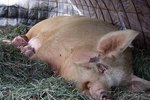
If your guinea pig is expecting a litter of pups, you are in for a treat! Not only will the newborn "piglets" appear completely furred, with a full set of teeth and capable of eating solid food within hours of delivery, you will have the pleasure of getting to know these highly social creatures right from the start.
Newborns

Newborn guinea piglets can range from 3 to 6 inches in length. A typical litter may have anywhere from one to six pups, and the larger the litter, the smaller the pups will usually be. Although they can eat solid food almost immediately after birth, they still need to nurse and will not be completely weaned off of their mother's milk for three to six weeks. It is fine to carefully handle your new guinea pig pups during this time, but be sure to allow them plenty of time with their mother, as well.
Separating your Piglets
By the time your piglets are 6 weeks old, the females are sexually mature and can become pregnant. It is important to separate your litter at this time to avoid inbreeding between the brothers and sisters, which could lead to genetic abnormalities in the next generation. To determine which are male and which are female, gently press on each pup's lower belly. A small protrusion will appear in the genital area if it is a male. If the pup is a female, there will be no protrusion.
Growing Your Pig

Your baby piglets will grow rapidly and may even double their size to 6 to 8 inches by the time they are 8 weeks old. Feed your pups a high-fiber diet of timothy hay and grasses, and allow them to nurse on their mother's milk for the first three to six weeks after birth. Be sure to include sources of vitamin C every day. A piece of orange or bits of kale, dandelion greens or a few berries each day is enough to ensure your baby pigs stay healthy.
Maturing Pigs
By the time your pigs are 16 weeks old, they will have matured considerably, reaching a length of 8 to 10 inches. Feed your developing pigs specially-formulated guinea pig pellets twice a day, in addition to an unlimited supply of hay or grass to ensure their proper development. Maturing female pigs will need additional vitamin C to keep them healthy, so add vitamin C drops to their fresh water each day.
Piggy Habits

Your guinea pig will be fully grown by 18 months old and will typically be anywhere from 8 to 12 inches from his nose to his rear end. Fully grown pigs will benefit from a diet of timothy hay and guinea pig pellets, with a few healthy bits of fruits and vegetables thrown in for good measure. Be careful not to overfeed your fully grown pig, as too many treats can pack on the pounds or create digestive difficulties that may lead to a cycle of illness.
References
Photo Credits
-
Hemera Technologies/Photos.com/Getty Images



